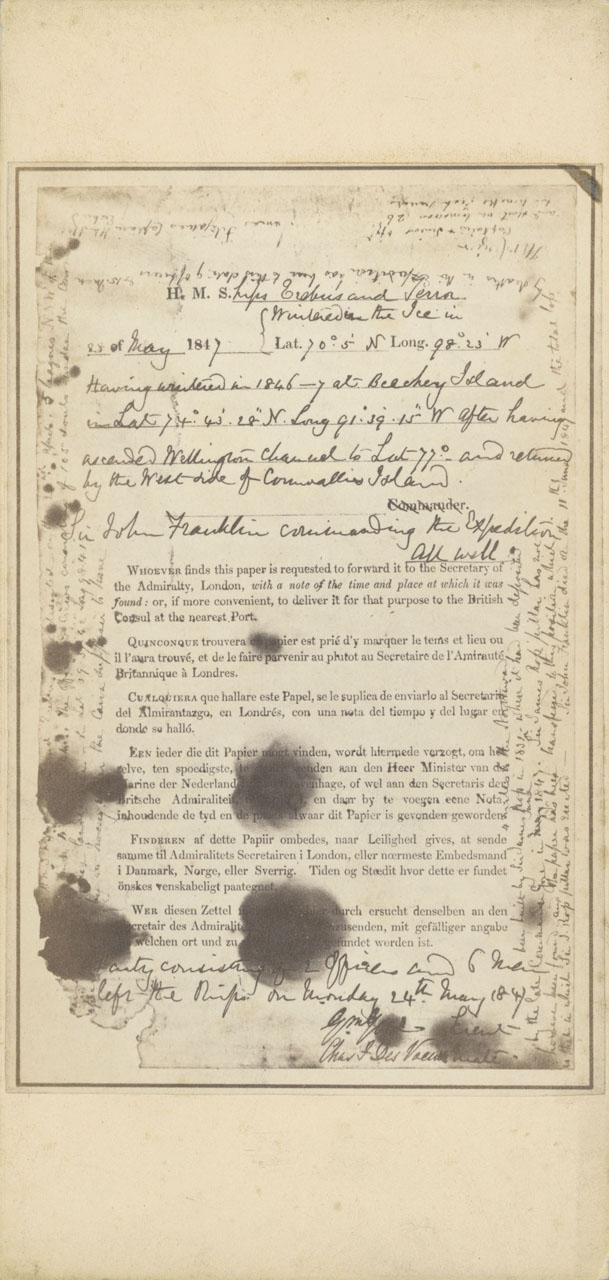
30 Sep 2016
The 2016 discovery of HMS Terror may shed new light on the much-debated fate of Franklin's final expedition. Our curators, Claire Warrior and Jeremy Michell, cover what we know of the story so far.
HMS Terror was built in Topsham, Devon, and launched in June 1813. She was a bomb vessel, with an extremely strong hull, built to withstand the impact of explosions. She began her career as a ship of war, involved in several battles of the War of 1812 against the United States. Terror was one of the vessels that bombarded Fort McHenry in the Battle of Baltimore, which inspired the American national anthem, ‘The Star-Spangled Banner’. After the end of the war, the ship served in the Mediterranean until she ran aground near Lisbon and was withdrawn from service.
When her career as a bomb vessel came to an end, Terror became a ship of exploration. She ventured north to the Arctic in 1836, under the command of George Back.
Trapped in the aptly-named Frozen Strait, she suffered heavy ice damage and eventually limped back home in July 1837, making it as far as Ireland
Her next expedition was to the opposite end of the Earth, the Antarctic (1839–43), under the command of James Clark Ross.
For this she was completely refitted at Chatham Dockyard with additional strengthening along the hull and the bow, an internal heating system and light optics in the deck to throw light into the cabins below. Along with HMS Erebus, she circumnavigated the continent and the expedition did much to map areas of Antarctica, the Ross Ice Shelf and set the scene for future polar exploration in that area.
On her return with HMS Erebus, Terror was again refitted, this time at Woolwich Dockyard, and prepared for a voyage of scientific and geographical exploration through the Northwest Passage under Sir John Franklin. In addition to being fitted similar to her 1839 voyage, both ships had additional planking on the upper deck and 20ft of iron sheeting along the sides from the bows. They also had steam engines and propellers added, which can be seen in green ink on the plan and required the stern to be rebuilt.

This was a brave decision, since the experiments with propellers were still underway within the Navy, and an engine with its need for coal would reduce the storage space for equipment and stores.
Finally she set sail for the Northwest Passage in 1845 and was last seen by the whaler Enterprise on 28 July 1845 secured to an iceberg. The last definite information we have is that she was abandoned, along with Erebus, on 22 April 1848 from a message left by Captains Crozier and Fitzjames.

What happened to her crew has remained the subject of speculation: while all the men are known to have died, the exact circumstances in which they perished are still to be discovered.
HMS Terror was rediscovered, appropriately, in Terror Bay, King William Island, on 12 September 2016.

Unexpectedly well-preserved, we hope that she’ll tell us more about the 1845 expedition, the state and fitting out of the ship, the equipment and any stores left on board before being abandoned.
